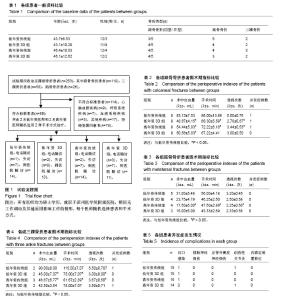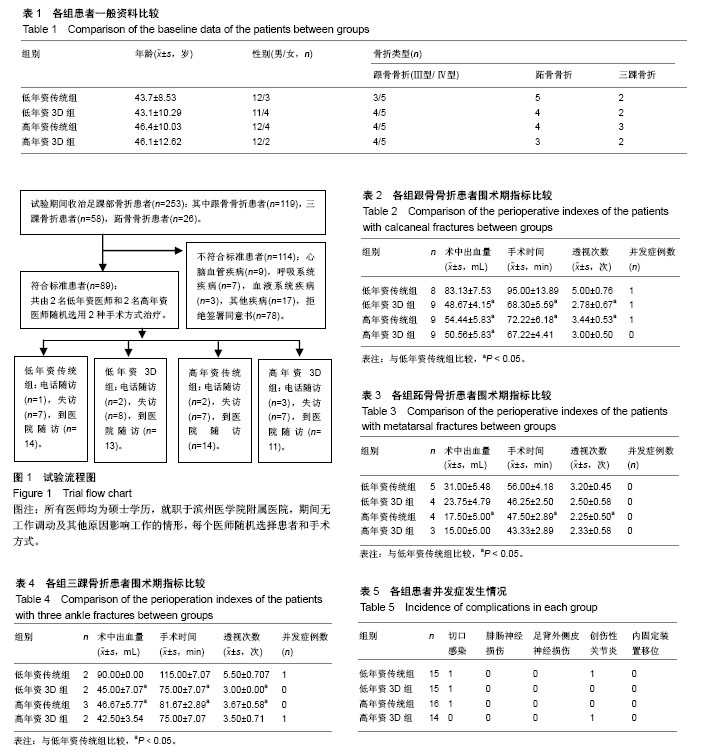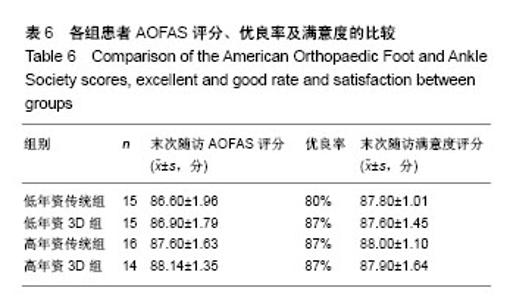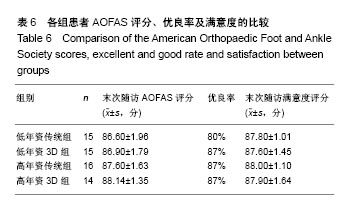| [1] 李浩博,陈雁西. 数字化技术在足踝外科的应用现状及展望[J]. 中华创伤骨科杂志, 2014,16(12): 1081-1084.[2] 俞光荣,赵宏谋. 足踝外科的演进[J]. 中国矫形外科杂志, 2009, 7(22): 1681-1684.[3] 邵佳申,常恒瑞,郑占乐,等. 3D打印辅助手术治疗胫骨平台骨折疗效的Meta分析[J]. 中国组织工程研究, 2017,21(23): 3767-3772.[4] Rengier F, Mehndiratta A, von Tengg-Kobligk H, et al.3D printing based on imaging data: review of medical applications. Int J Comput Assist Radiol Surg. 2010; 5(4): 335-341.[5] 姜雨晨,陈雁西.3D打印技术在足踝外科的应用价值[J]. 国际骨科学杂志, 2015,36(1): 15-17.[6] Kline AJ, Anderson RB, Davis WH, et al. Minimally invasive technique versus an extensile lateral approach for intra-articular calcaneal fractures. Foot Ankle Int. 2013;34(6): 773-780.[7] Bagaria V, Deshpande S, Rasalkar DD, et al. Use of rapid prototyping and three-dimensional reconstruction modeling in the management of complex fractures. Eur J Radiol. 2011; 80(3): 814-20.[8] 章莹,万磊,尹庆水,等. 计算机快速成型辅助个体化三踝骨折的手术治疗[J]. 中华创伤骨科杂志, 2009,11(6): 509-511.[9] Chung KJ, Hong DY, Kim YT, et al. Preshaping plates for minimally invasive fixation of calcaneal fractures using a real-size 3D-printed model as a preoperative and intraoperative tool. Foot Ankle Int. 2014;35(11): 1231-1236.[10] Chung KJ, Huang B, Choi CH, et al. Utility of 3D printing for complex distal tibial fractures and malleolar avulsion fractures: Technical Tip. Foot Ankle Int. 2015;36(12):1504-1510.[11] Ryken TC, Kim J, Owen BD, et al. Engineering patient-specific drill templates and bioabsorbable posterior cervical plates: a feasibility study. J Neurosurg Spine. 2009; 10(2):129-132.[12] Starosolski ZA, Kan JH, Rosenfeld SD, et al. Application of 3-D printing (rapid prototyping) for creating physical models of pediatric orthopedic disorders. Pediatr Radiol. 2014;44(2): 216-221.[13] Zhang T, Su Y, Chen W, et al. Displaced intra-articular calcaneal fractures treated in a minimally invasive fashion: longitudinal approach versus sinus tarsi approach. J Bone Joint Surg Am. 2014;96(4): 302-309.[14] Madeley NJ, Wing KJ, Topliss C, et al. Responsiveness and validity of the SF-36, Ankle Osteoarthritis Scale, AOFAS Ankle Hindfoot Score, and Foot Function Index in end stage ankle arthritis. Foot Ankle Int. 2012;33(1): 57-63.[15] 许可,蒲晓鹏, 郑旺,等. 3D打印个体化椎弓根导板研制及模拟置钉的准确性[J]. 中国组织工程研究, 2017,21(23): 3724-3729.[16] 李明,孙亮,马腾,等.3D打印快速成型技术在髋臼骨折分型及年轻医生培养中的应用[J]. 中华创伤骨科杂志, 2017,19(2): 140-145.[17] Bergeson RK, Schwend RM, DeLucia T, et al. How accurately do novice surgeons place thoracic pedicle screws with the free hand technique? Spine (Phila Pa 1976). 2008;33(15): E501-507.[18] Upendra BN, Meena D, Chowdhury B, et al. Outcome-based classification for assessment of thoracic pedicular screw placement. Spine (Phila Pa 1976). 2008;33(4): 384-390.[19] Lu S, Zhang YZ, Wang Z, et al. Accuracy and efficacy of thoracic pedicle screws in scoliosis with patient-specific drill template. Med Biol Eng Comput. 2012;50(7): 751-758.[20] Smorgick Y, Millgram MA, Anekstein Y, et al. Accuracy and safety of thoracic pedicle screw placement in spinal deformities. J Spinal Disord Tech. 2005; 18(6): 522-526.[21] 郭鹏年,董乐乐,左强,等. 3D打印技术在创伤骨科中的临床应用[J]. 中国数字医学, 2015,10(6): 45-47.[22] Hurson C, Tansey A, O'Donnchadha B, et al. Rapid prototyping in the assessment, classification and preoperative planning of acetabular fractures. Injury. 2007;38(10): 1158-1162.[23] 马晨光,纪颖,薛迪. 3D打印技术骨科临床应用效应系统性综述[J]. 中国医院管理, 2017,37(5): 35-38.[24] 刘琨,赵汝岗,张强. 3D打印技术在骨科的应用研究进展[J]. 中华创伤骨科杂志, 2015,17(1): 63-66.[25] Fukushima K, Takahira N, Uchiyama K, et al. Pre-operative simulation of periacetabular osteotomy via a three-dimensional model constructed from salt. SICOT J. 2017;3: 14.[26] Hieu LC, Bohez E, Vander Sloten J, et al. Design and manufacturing of cranioplasty implants by 3-axis cnc milling. Technol Health Care. 2002;10(5): 413-423.[27] 周烨,张宏斌,王捷. 快速成型技术在复杂性骨折方面的临床应用[J]. 中国数字医学, 2012, 7(7): 108-110.[28] 王岩.骨科精准医疗:应用与思考[J].中华医学杂志, 2015,95(31): 2512-2514.[29] Liu K, Zhang Q, Li X, et al. Preliminary application of a multi-level 3D printing drill guide template for pedicle screw placement in severe and rigid scoliosis. Eur Spine J. 2017; 26(6):1684-1689.[30] Golab A, Smektala T, Kaczmarek K, et al. Laparoscopic partial nephrectomy supported by training involving personalized silicone replica poured in three-dimensional printed casting mold. J Laparoendosc Adv Surg Tech A. 2017;27(4): 420-422.[31] Guo F, Dai J, Zhang J, et al. Individualized 3D printing navigation template for pedicle screw fixation in upper cervical spine. PLoS One. 2017;12(2): e0171509. |



